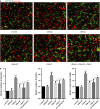MicroRNA-132/212 family enhances arteriogenesis after hindlimb ischaemia through modulation of the Ras-MAPK pathway
- PMID: 25945589
- PMCID: PMC4549050
- DOI: 10.1111/jcmm.12586
MicroRNA-132/212 family enhances arteriogenesis after hindlimb ischaemia through modulation of the Ras-MAPK pathway
Abstract
Arteriogenesis is a complicated process induced by increased local shear-and radial wall-stress, leading to an increase in arterial diameter. This process is enhanced by growth factors secreted by both inflammatory and endothelial cells in response to physical stress. Although therapeutic promotion of arteriogenesis is of great interest for ischaemic diseases, little is known about the modulation of the signalling cascades via microRNAs. We observed that miR-132/212 expression was significantly upregulated after occlusion of the femoral artery. miR-132/212 knockout (KO) mice display a slower perfusion recovery after hind-limb ischaemia compared to wildtype (WT) mice. Immunohistochemical analysis demonstrates a clear trend towards smaller collateral arteries in KO mice. Although Ex vivo aortic ring assays score similar number of branches in miR-132/212 KO mice compared to WT, it can be stimulated with exogenous miR-132, a dominant member of the miR-132/212 family. Moreover, in in vitro pericyte-endothelial co-culture cell assays, overexpression of miR-132 and mir-212 in endothelial cells results in enhanced vascularization, as shown by an increase in tubular structures and junctions. Our results suggested that miR-132/212 may exert their effects by enhancing the Ras-Mitogen-activated protein kinases MAPK signalling pathway through direct inhibition of Rasa1, and Spred1. The miR-132/212 cluster promotes arteriogenesis by modulating Ras-MAPK signalling via direct targeting of its inhibitors Rasa1 and Spred1.
Keywords: Ras-MAPK; arteriogenesis; hindlimb ischaemia; miR-132/212.
© 2015 The Authors. Journal of Cellular and Molecular Medicine published by John Wiley & Sons Ltd and Foundation for Cellular and Molecular Medicine.
Figures







References
-
- Revencu N, Boon LM, Mendola A, et al. RASA1 mutations and associated phenotypes in 68 families with capillary malformation-arteriovenous malformation. Hum Mutat. 2013;34:1632–41. - PubMed
-
- Troidl K, Schaper W. Arteriogenesis versus angiogenesis in peripheral artery disease. Diabetes Metab Res Rev. 2012;28:27–9. - PubMed
-
- Shimpo M, Ikeda U, Maeda Y, et al. AAV-mediated VEGF gene transfer into skeletal muscle stimulates angiogenesis and improves blood flow in a rat hindlimb ischemia model. Cardiovasc Res. 2002;53:993–1001. - PubMed
Publication types
MeSH terms
Substances
LinkOut - more resources
Full Text Sources
Other Literature Sources
Molecular Biology Databases
Research Materials
Miscellaneous

